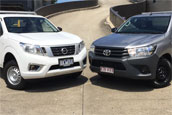Do you know your consumer rights?
In this video, the ACCC explains what your consumer rights are.
PT1M40S 620 349Australia's large listed retailers are still playing catch-up in online retailing compared with smaller peers, despite investing hundreds of millions of dollars into improving e-commerce systems.
Online sales at Australia's 10 largest listed retailers represent on average 5.9 per cent of total sales, well below national online retail spending of almost 11 per cent and average global online sales "penetration" of 11 per cent, a Citigroup report says.
The figures are based on an analysis of 110 retailers around the world, including supermarkets, department stores, clothing retailers and consumer electronics chains.

The footprint of Australia's major retailers may be too large for them to get a large proportion of sales from digital channels. Photo: Bloomberg
Craig Woolford, Citigroup Australia and New Zealand's head of research, said the study highlighted the low level of online penetration for large listed Australian retailers and suggested consumers were bypassing the large listed players when shopping online, spending their money at unlisted Australian retailers and overseas online retailers such as Amazon, eBay, Apple, asos.com and boohoo.com.
"It's not that the consumer is lagging behind – this is the large ASX-listed retailers lagging behind," Mr Woolford said.
Bypassing ASX-listed retailers

Online sales penetration at large listed retailers such as Coles and Woolworths is well below the national and global average. Photo: Quinn Rooney
"On our calculations in non-food retailing 12 per cent [of sales] are done online by consumers, but the vast majority of that is bypassing the ASX-listed retailers and going to other sources," he said.
In 2015, online retailing represented 3 per cent of sales at Woolworths, one of the first food retailers to establish online grocery and liquor shopping, and 2 per cent at Wesfarmers' retail businesses. This compared with 7 per cent for British food retailer Tesco, 5 per cent for Carrefour, 4 per cent at Ahold and 3 per cent at Walmart.
"While online sales in grocery are taking share in Australia, we doubt the sales are incremental and are likely cannibalising bricks-and-mortar stores," the Citigroup report said.
Australian department stores have lifted their game in recent years, investing hundreds of millions of dollars into new e-commerce platforms, fulfilment systems and click-and-collect facilities. Yet online sales represented just 2.8 per cent of sales at Myer in 2015 and 3 per cent at David Jones, compared with 19 per cent at Macy's, 16 per cent at Nordstrom, 15 per cent at Marks and Spencer and 14 per cent at Debenhams.
In clothing and accessories, online penetration in Australia averages 6 per cent, in line with that at large global chains such as H&M and Zara, but penetration rates vary widely.
For example, Oroton generated 10 per cent of sales online in 2015 and Specialty Fashion 9 per cent, but Premier Investments' online sales were about 3 per cent and footwear retailer RCG Group 1 per cent, the Citigroup report said.
In consumer electronics and hardware, online penetration at JB Hi-Fi (2 per cent), Harvey Norman (1 per cent) and Bunnings (1 per cent) was well below that at offshore chains such as Dixons Carphone (23 per cent), Best Buy (11 per cent), Home Depot (5 per cent) and Kingfisher (3 per cent).
Lack of digital expertise
Mr Woolford said Australian listed retailers were behind the eight ball because of underinvestment in e-commerce systems, a lack of digital expertise, especially at board level, and less-than-compelling online offers.
The global report found that 52 per cent of retailers in the study had a board member with direct experience at a tech company. Only three of the Australian companies sampled – Wesfarmers, RCG Corp and Super Retail Group – had a board member with tech company experience.
"If Australian retailers are going to win online they have to have an attractive and superior offer to those global offerings – either better prices, faster delivery, or click and collect," Mr Woolford said.
In some cases retailers had spent heavily on new e-commerce platforms, only to discover that their existing inventory, merchandise or point-of-sale systems were not up to the challenge, or that systems installed three or four years ago were already out of date as online spending moved to mobile devices.
Australian retailers have very large retail footprints, making it easier for consumers to shop at bricks-and-mortar stores, whereas retailers around the world that are most successful online tend to have smaller retail footprints but strong global brand awareness.
For example, Urban Outfitters' online sales penetration is 32 per cent and Abercrombie & Fitch's is 24 per cent.
"If Australian retailers want to compete on that basis, for some it will be about reducing their store base," Mr Woolford said.


























